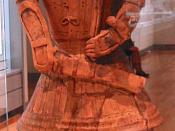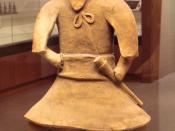Haniwa: Kofun period, 6th century ce. Earthenware
Womb World mandala: Heian period, late 9th century ce. Hanging Scroll
Detail of Night Attack on the Sanjo Palace: Kamakura period, late 13th century ce. Handscroll
In Japan, when an emperor died, large chamber tombs were constructed. The Japanese government has never allowed the major sacred tombs to be excavated. Some of these sites had artificial hills built over the tombs themselves. On the top the hills were placed ceramic works of sculpture called haniwa. The first haniwa were simple cylinders that may have held jars with ceremonial offerings. Gradually these cylinders came to be made in the shapes of ceremonial objects, houses, and boats. Still later, living creatures were added to the repertoire of haniwa subjects including birds, deer, dogs, monkeys, cows, and horses. Finally, haniwa in human shapes were crafted, including male and females of all types, professions, and classes. Haniwa illustrate several enduring characteristics of Japanese aesthetic taste.
Unlike Chinese tomb ceramics, which were often beautifully glazed, haniwa were left unglazed to reveal their clay bodies. Nor do haniwa show the interest in technical skill seen in Chinese ceramics. Instead, their makers explored the expressive potentials of simples and bold form. Haniwa shapes are never perfectly symmetrical; the slightly off-center placement of the eye slits, the irregular cylindrical bodies, and the unequal arms give them great life and individuality. No one knows what purpose haniwa served. The popular belief that they were tomb guardians is weakened by their origin as cylinders and by the mundane subjects they portray. Indeed, they seem to represent every aspect of Kofun-period society. They may also reflect some of the beliefs of Shinto.
The Japanese fully absorbed and transformed the influences from China and Korea during the Heian period. The formation of efficient writing system...


